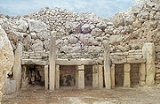
Ggantija phase
Encyclopedia
The Ġgantija phase owes its name to the Ġgantija Temples
in Xagħra, Gozo
. The Ġgantija phase is directly preceded by the Mġarr phase
(3800-3600 BCE), and is characterized by a change in the way the prehistoric inhabitants of Malta
lived. The Ġgantija Phase evolved into the Saflieni
and Tarxien phase
s (3000-2500 BCE), named after the unique subterranean temple known as the Hypogeum of Ħal-Saflieni and the Tarxien Temples
, respectively.
 The temples of Ġgantija are one of the Megalithic Temples of Malta
The temples of Ġgantija are one of the Megalithic Temples of Malta
and were first excavated in 1827 by John Otto Bayer. They are built with coralline limestone blocks and each temple contains five apses connected by a central corridor leading to an innermost trefoil section. The first temple is larger and contains a variety of features such as altars, relief carvings and libation holes. The second temple was built later and is devoid of such features. Also of interest is the corbelling technique evident on the inwardly inclined walls, suggesting that the temple was roofed. Burial in the Ġgantija Phase continues in the shaft and chamber tomb style established by the Żebbuġ phase (4100-3800 BCE) culture.
Local folklore
interpreting these gigantic structures, in particular those of Ġgantija, maintain they were built by giants; Ġgantija is a Maltese
word meaning 'Place of the Giants'.
Ggantija
Ġgantija is a Neolithic, megalithic temple complex on the Mediterranean island of Gozo. The Ġgantija temples are the earliest of a series of megalithic temples in Malta. Their makers erected the two Ġgantija temples during the Neolithic Age , which makes these temples more than 5500 years old and...
in Xagħra, Gozo
Gozo
Gozo is a small island of the Maltese archipelago in the Mediterranean Sea. The island is part of the Southern European country of Malta; after the island of Malta itself, it is the second-largest island in the archipelago...
. The Ġgantija phase is directly preceded by the Mġarr phase
Mgarr phase
Following the Żebbuġ phase , the Mġarr phase was a short transitional period in Malta's prehistory. It is characterized by pottery consisting of mainly curved lines. Examples have been extensively excavated at the Ta' Ħaġrat Temples...
(3800-3600 BCE), and is characterized by a change in the way the prehistoric inhabitants of Malta
Malta
Malta , officially known as the Republic of Malta , is a Southern European country consisting of an archipelago situated in the centre of the Mediterranean, south of Sicily, east of Tunisia and north of Libya, with Gibraltar to the west and Alexandria to the east.Malta covers just over in...
lived. The Ġgantija Phase evolved into the Saflieni
Saflieni phase
The Saflieni phase of Malta's prehistory was named after the Hypogeum of Ħal-Saflieni. The hypogeum and part of the Ta' Ħaġrat temple complex both date from this period....
and Tarxien phase
Tarxien phase
The Tarxien phase followed the Saflieni phase and typifies the last and most advanced period of temple building in prehistoric Malta...
s (3000-2500 BCE), named after the unique subterranean temple known as the Hypogeum of Ħal-Saflieni and the Tarxien Temples
Tarxien Temples
The Tarxien Temples are an archaeological complex in Tarxien, Malta. They date back to approximately 2800 BC. The site was accepted as a UNESCO World Heritage Site in 1980 along with the other Megalithic temples on the island of Malta.-Description:...
, respectively.
Ġgantija overview

Megalithic Temples of Malta
The Megalithic Temples of Malta are a series of prehistoric monuments in Malta of which seven are UNESCO World Heritage Sites. Archaeologists believe that these megalithic complexes are the result of local innovations in a process of cultural evolution...
and were first excavated in 1827 by John Otto Bayer. They are built with coralline limestone blocks and each temple contains five apses connected by a central corridor leading to an innermost trefoil section. The first temple is larger and contains a variety of features such as altars, relief carvings and libation holes. The second temple was built later and is devoid of such features. Also of interest is the corbelling technique evident on the inwardly inclined walls, suggesting that the temple was roofed. Burial in the Ġgantija Phase continues in the shaft and chamber tomb style established by the Żebbuġ phase (4100-3800 BCE) culture.
Local folklore
Maltese folklore
Maltese folklore is the folk tradition which has developed in Malta over the centuries, and expresses the cultural identity of the Maltese people.- Festas :...
interpreting these gigantic structures, in particular those of Ġgantija, maintain they were built by giants; Ġgantija is a Maltese
Maltese language
Maltese is the national language of Malta, and a co-official language of the country alongside English,while also serving as an official language of the European Union, the only Semitic language so distinguished. Maltese is descended from Siculo-Arabic...
word meaning 'Place of the Giants'.

